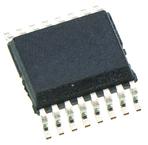herunterladen

a
AN-273
APPLICATION NOTE
One Technology Way • P.O. Box 9106 • Norwood, MA 02062-9106 • 781/329-4700 • World Wide Web Site: http://www.analog.com
Use of the AD590 Temperature Transducer
in a Remote Sensing Application
by Paul Klonowski
INTRODUCTION
The AD590 is a two-terminal integrated circuit tempera-
ture transducer that produces an output proportional to
absolute temperature. For supply voltages between +4 V
and +30 V the device acts as a high impedance, constant
current source supplying 1 µA/K. Laser trimming of the
chip’s thin-film resistors is used to calibrate the device
to an output of 298.2 µA at 298.2K (+25°C).
A typical application for the AD590 is a remote tempera-
ture-to-current transducer. Figure 1 shows a thermom-
eter circuit that measures temperature from –55°C to
+100°C and whose output voltage is 100 mV/°C. Since
the AD590 measures absolute temperature (its nominal
output is 1 µA/K), the output must be offset by 273.2 µA
in order to read out in degrees Celsius. The output cur-
rent of the AD590 flows through a 1 kΩ resistance, devel-
oping a voltage of 1 mV/K. The output of the AD580 2.5 V
reference is divided down by resistors to provide a
273.2 mV offset, which is subtracted from the voltage
across the 1 kΩ resistor by an AD524 instrumentation
amplifier. The amplifier provides a gain of 100, so that
the output range corresponding to –55°C to +100°C is
–5.5 V to +10 V (100 mV/°C). An operational amplifier can
substitute for the instrumentation amplifier, although
care must be taken when designing with the
op amp since the gain at the two input terminals will be
different.
THE PROBLEM
A question often asked of Analog Devices Applications
Engineers by customers using the AD590 in a remote
temperature-to-current application is, “How long can I
make the cable and how can I eliminate any noise that
the cable picks up?” Experiments were performed in an
effort to provide some guidelines for answering this
question using the circuit of Figure 1 with a 1000'
shielded, though initially ungrounded, twisted pair cable
(Belden 9461, style 2092). In order to duplicate actual
conditions the experiments were performed in an indus-
trial environment.
TYPES OF NOISE
There are three basic types of noise inherent in a
data-acquisition system. The first type is
transmitted
noise
: noise received with the original signal and indis-
tinguishable from it. The second type is
intrinsic
noise:
noise generated within the devices used in a circuit, e.g.,
resistors, op amps, etc. Included in this category are
Johnson, shot and popcorn noise. The third type is
induced noise
: noise picked up from the outside world
and coupled into the circuit. This application note dis-
cusses methods of reducing induced noise, which is the
only form of noise that can be influenced by choices of
wiring and shielding.
AD590
I
T
<
I
T
I
T
+
–
7V
+15V
AD580
909kV
200V
1kV
1kV
0.1% LOW
TCR RESISTOR
1mV/K
INSTRUMENTATION AMP
GAIN = 100, 100mV/8C
2kV
E
O
AD524
G = 100
RG
2
Figure 1. Thermometer Circuit








